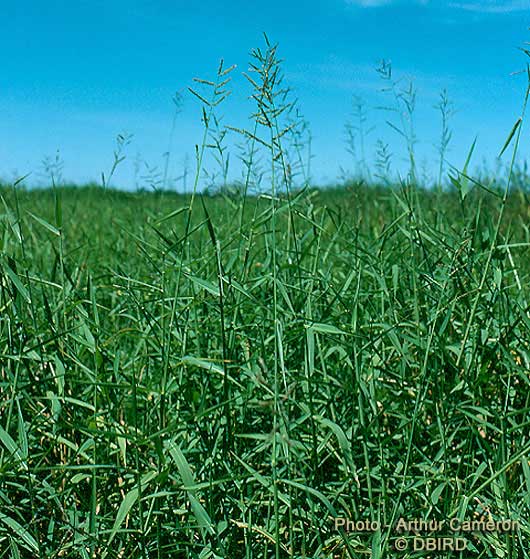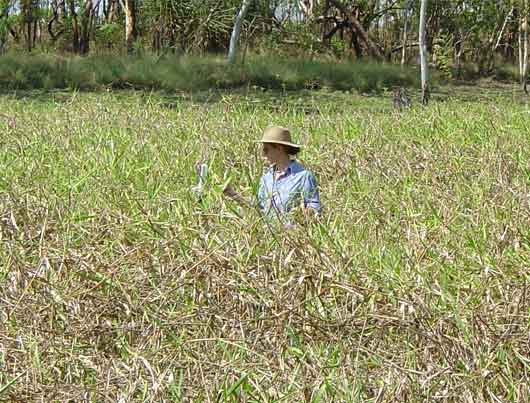Weediness and WRA
(Optional exercise for external students – this topic will be discussed in a classroom tutorial)
Weediness is in the eye of the beholder
For this optional activity you will use a risk assessment tool, that you will have been introduced to in Prevention section. You will use the tool to evaluate the invasive potential of two controversial grass species. The results of the assessment will allow you to answer two questions; your answers will be posted to the Discussion Forum
In some cases there is debate about which species are pests or weeds. For example, a large number of exotic pasture grasses have been introduced into Northern Australia for cattle production and some of these have become invasive weeds (see Whitehead & Wilson 2000).
Olive hymenachne (Hymenachne amplexicaulis) is one such species that is now declared as a weed of national significance. Para grass (Urochloa mutica) shows similar potential as an invasive species, but is widely used by the cattle industry and as a result is not declared as a weed. Para grass continues to be used despite evidence suggesting it is one of Australia's worst environmental weeds (e.g. Humphries et al 1991).
These species, and many more, were not subjected to Australia's risk assessment process that could now be applied prior to the importation of these species.
Activity 4.2
In this optional activity you will:
- Use the species information provided below to carry out a risk assessment for two grass species Para grass and Olive hymenachne.
- Consider the following questions on the Discussion Forum:
- Should the species you examined have been allowed into the country?
- How did the score for Agricultural versus Environmental risk score compare?
- What are the implications of these differences in (2)?
Using the WRA Tool
The WRA assessment tool that Biosecurity Australia uses asks questions on domestication, habitat preferences, biology and history of invasion and the answers are used to calculate a weed risk score. The score is used to determine an outcome: accept, reject or further evaluate for the species. The WRA also makes a prediction as to whether a species may be a weed of agriculture or the environment.
Tips on using the WRA tool:
- Read the instructions in the WRA question sheet (Form B)
- In many instances the question being asked may require clarification; use the notes on each of the questions in the instructions (See form A) to clarify what is being asked.
- In some instances you will not know the answer to a question, that's why the Don't Know option has been provided.
- If you're curious to see what impact having an extra piece of information might make, re-run the analysis and answer yes or no and note the difference in score.
- Now calculate the risk score using the Weed Risk Assessment scoring sheet (Form C) and run the risk analysis for the species.
NB: If you were going to apply the precautionary principle when using this tool you would assume the worst if you don't currently know the answer.
For a more detailed explanation of the precautionary principle and how it has been used see Case Study 3.3 on the GISP website.
SPECIES PROFILE: Para Grass

Para Grass. Photo courtesy of Arthur Cameron
Description:
Para grass (Urochloa mutica formerly Brachiaria mutica) a native of South America and Africa was introduced to Australia in the late 1800's as a pasture species. It is recognised as an environmental weed of Queensland, NSW, NT and WA.
A highly invasive perennial grass, growing to 2m, that spreads vigorously, choking out native species and hindering establishment of more desirable species. As a species well suited to grazing Para grass tolerates grazing and does well in disturbed habitats.
Habitat:
Wet or seasonally flooded areas in disturbed sites, including floodplains, drainage lines and creek banks.
Capable of forming dense mats 1-2m thick over waterbodies. Can tolerate water depths up to 1m, but survives the extended dry season when the floodplains are dry for several months.
Found predominantly in freshwater ecosystems, but will tolerate brackish water and is relatively shade tolerant.
Para grass has been extensively introduced into coastal floodplains in NT and QLD as pasture for cattle.
For the purposes of the exercise assume that we are undertaking a risk assessment for northern Australia and that therefore the species is highly suited to Australian climates.
Dispersal/Reproduction:
Spreads vegetatively and rapidly from stolon fragments, which are spread intentionally as pasture species, and also by floodwaters and birds and possibly by cattle and pigs.
Impacts and Control:
Because of its extensive use as a pasture species, Para grass is not officially listed as a noxious weed in any of the states or territories where it is recognised as an environmental weed.
It continues to be considered a useful pasture species despite infestations having adverse impacts on wildlife, traditional hunting practices and, in Queensland, sugarcane production.
Under favourable conditions para grass forms dense monospecific stands excluding other species. In addition to the habitat modification implications for wildlife, these infestations can increase the fuel load leading to more intense grassland fires.
Foliar sprays (herbicides) can used means of controlling infestations.
Source: Weeds of the wet/dry tropics: A field guide. Nicholas M. Smith (2002).
Further Information:
Queensland Department of Natural Resources and Mines.
SPECIES PROFILE: Olive Hymenache

Olive Hymenache infestation
Description:
Olive hymenachne (Hymenachne amplexicaulis) is a perennial grass that grows to 1.6m, spreads on dryland and floats in water. Another native of South America it was introduced to Queensland as a ponded pasture species.
Olive hymenachne is a declared Weed of National Significance (WONS) and is a prohibited entrant under NT legislation.
Hymenachne acutigluma is a native species found in Queensland and the northern territory. Both species are sometimes referred to as "hymenachne" and both are used for grazing cattle. Hymenachne amplexicaulis is easily distinguished from the native hymenachne by the possession of stem clasping leaf bases.
As a species well suited to grazing Olive, hymenachne tolerates grazing and does well in disturbed habitats.
Habitat:
Olive hymenachne prefers low-lying areas along the edges of waterbodies and within seasonally inundated areas where the soil is inundated in summer / wet season up to 2m and moist but not inundated during winter / dry season. It can tolerate short periods of drought.
For the purposes of the exercise assume that we are undertaking a risk assessment for northern Australia and that therefore the species is highly suited to Australian climates.
Dispersal/Reproduction:
Olive Hymenachne produces abundant viable seed that is dispersed in water and in stockfeed. Vegetative material is also spread by floodwaters, possibly by birds and intentionally as a pasture species.
Impacts and Control:
Hymenachne is recognised as a WONS because of its ability to smother native vegetation and form dense monospecific stands.
Foliar sprays (herbicides) have been used means of controlling infestations.
Further Information:
- Olive Hymenachne (declared)
Weeds of national significance: Hymnenachne Strategic Plan - Queensland Department of Natural Resources and Mines. NRM Facts: Pest series - Hymenachne amplexicaulis.